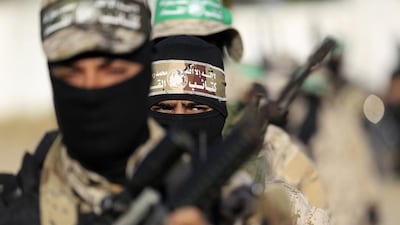The confrontation over Qatar’s policies is being misunderstood in parts of the international community as merely a parochial and petty “spat” between local rivals. But, to the contrary, this complex dynamic reflects a profound and regionwide ideological struggle being waged in three key areas of the Arab world: Qatar in the Gulf, Gaza in the Levant, and Libya in North Africa.
At issue is nothing less than the character, role and future of the Muslim Brotherhood and similar Islamist groups across the region.
The military-led removal of Egyptian president Mohammed Morsi from office in 2013, and its aftermath, plunged Brotherhood parties throughout the Arab world into an existential crisis. Indeed, the traditional Brotherhood movement - established in Egypt in the 1920s and structured around an essentially Leninist methodology of urban revolutionary vanguardism - seems to be disintegrating.
Many Brotherhood groups are seeking to adapt and remain viable by evolving into legitimate, post-revolutionary and effectively post-Islamist conservative political parties. These include Ennahda in Tunisia, the Justice and Development Party in Morocco, the mainstream Brotherhood in Jordan, large elements of Al-Islah in Yemen, and similar groups in Kuwait and elsewhere.
Muslim Brotherhood members who find such moderation intolerable are instead being pulled towards far more fanatical groups like Al Qaeda, ISIL or other Salafist-Jihadist terror organisations.
Between the imperative of moderation and the lure of extremism, the familiar but dwindling conventional Muslim Brotherhood movement has just a few, albeit significant, remaining redoubts.
Qatar’s deep-pocketed soft power and media empire, featuring Al Jazeera, serves as the Brotherhood’s bankroll and megaphone. Hamas’s rule in Gaza is the Brotherhood’s last de facto government and primary territorial enclave. And Brotherhood affiliates in Libya remain potent fighting and political forces.
But all three are now being simultaneously challenged by non-Islamist Arab powers. Egypt and the United Arab Emirates, for example, are involved in pressuring both Qatar and Hamas, and combating radicals in Libya.
The Palestinian Authority, Egypt and Israel are directly pressing Hamas to loosen its grip over Gaza and its almost two million long-suffering Palestinian residents.
Egypt and Israel tightly control movement in and out of Gaza. Western restrictions on dealing with Hamas, widely designated to be a terrorist organisation, have greatly hampered humanitarian and development work. The UN says living conditions have become “more and more wretched” during the decade of Hamas rule.
Now, fed up with Hamas’s recalcitrance, the PA has imposed additional measures, squeezing both Gaza’s beleaguered population and their rulers. If Hamas insists on violently enforcing a monopoly of power in Gaza, the PA is saying, it must bear the costs itself.
Hamas demands the PA finance Gaza’s electricity, but Ramallah has cut payments to Israeli suppliers. It also slashed the salaries of some public employees and prisoners’ families, among other measures.
Hamas is exhibiting clear signs of stress. In April it floated a new “charter” that is more moderate than, but does not abrogate or replace, its hideous 1988 founding document. Hamas thus now has two operative formal mission statements, one for its radical base and another for everyone else. No one is fooled.
Hamas historically relies on support from Turkey and, especially, Qatar, where the “new charter” was unveiled.
But Turkey has resumed close relations with Israel. With its political attention turned inward, Turkey now serves more as a refuge for marooned Brotherhood leaders than a potent patron. Doha faces bigger problems than Ankara, and can do little to shore up Hamas.
In Libya, the third major front in this ideological confrontation, Qatar’s clients - mainly affiliated with the Brotherhood and the “Libya Dawn” militia that dominates Tripoli - are also struggling. General Khalifa Haftar’s anti-Islamist “Libyan National Army,” supported by Egypt and the UAE, recently consolidated control over Benghazi and several crucial oil terminals, as well as its base in Tobruk.
As with the crises involving Qatar and Hamas, the battle in Libya in part represents a confrontation between some of the last viable remnants of the traditional iteration of the Muslim Brotherhood versus Arab forces opposed to radical Islamism.
If Qatar is forced to abandon its pro-Brotherhood policies, Hamas is compelled to loosen its grip on Gaza and anti-Islamist forces consolidate control over key areas of Libya, then it may be very difficult for the familiar Brotherhood movement of the 20th century to remain politically functional for much more of the 21st.
Such developments would surely fast-track an emerging binary choice facing Muslim Brothers. They can follow the pragmatic path of Rachid Ghannouchi and Ennahda, and become post-revolutionary, and essentially post-Islamist, legitimate conservative Muslim political parties. Or they can go the violent way of Abu Bakr Al Baghdadi and ISIL, and join nihilistic, and essentially psychotic, terrorist groups.
There are numerous facets and particularities to the Qatar crisis and the struggles over Gaza and Libya.
But the ideological clash embedded in all three regarding the viability and future of the traditional revolutionary and subversive, but only strategically violent, Muslim Brotherhood – as opposed to the emergent alternatives of the developing legitimate post-Islamist conservative Muslim parties or the universally reviled ultra-terrorists – is certainly the most regionally and historically consequential.
Hussein Ibish is a senior resident scholar at the Arab Gulf States Institute in Washington


